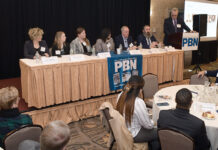Martin Bide, a professor at the University of Rhode Island, has been elected president of the American Association of Textile Chemists and Colorists. Bide has previously served the AATCC as its New England vice president and as the chair of committees on applied dyeing theory, health and environmental technology, safety and publications. His two-year term will begin next month. His research at URI currently focuses on developing infection-resistant sutures.
PBN: What is your background?
BIDE: My academic background is as a color chemist. I started on this path in the U.K. Color chemistry involves fibers and dyeing, and I earned my Ph.D. as an organic chemist, developing new dyes. I spent five years in the dyestuff industry in the U.K. before joining the faculty of the University of Massachusetts-Dartmouth in 1981, and moving to URI in 1991. Throughout my academic career in the U.S., I have been involved with AATCC in New England, where I have met the technical leaders of the textile industry. Those interactions have been invaluable in making my teaching of textile science more “real-world,” and have taught me a lot more than I learned in the classroom.
PBN: What is the AATCC’s purpose?
BIDE: This is an organization that sets worldwide standards. … AATCC organizes conferences and symposia, and develops tests that are used worldwide to ensure, for example, that fabrics don’t fade or bleed in use. It publishes a magazine, AATCC Review. Compared to other associations I know, AATCC is a good mix of the practical and the academic. As president, I’ll be the public face of the association … representing AATCC at conferences in the U.S. and in several foreign countries.
PBN: What are the major issues for the textile industry?
BIDE: The issues facing the textile industry in the U.S. and in Rhode Island are familiar ones: Imports from low-wage countries make it difficult for U.S. production to be competitive. The survivors are finding interesting ways to maintain their niche, and I commend them for their creativity. Increasingly, AATCC in the U.S. represents not only the dyer and finisher, but also the designers and merchandisers who control the textile supply chain.












